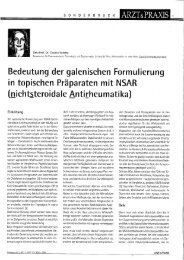Diclofenac Sodium 4% Spray Gel - cyathus.cz
Diclofenac Sodium 4% Spray Gel - cyathus.cz
Diclofenac Sodium 4% Spray Gel - cyathus.cz
You also want an ePaper? Increase the reach of your titles
YUMPU automatically turns print PDFs into web optimized ePapers that Google loves.
PAR <strong>Diclofenac</strong> <strong>Sodium</strong> <strong>4%</strong> <strong>Spray</strong> <strong>Gel</strong><br />
UK/H/0562-3/001/E01<br />
There are species differences in the metabolism of diclofenac. <strong>Diclofenac</strong> is either<br />
directly conjugated or oxidised at various positions (position 3′ or 4′ of the<br />
dichlorophenyl moiety, position 5' of the phenyl ring or simultaneously at positions 5′<br />
and 4′) prior to conjugation.<br />
The more important route of elimination in rat and dog is through bile, as opposed to<br />
renal excretion in monkey and man. The terminal plasma elimination half-life (t½β)<br />
of unchanged diclofenac after an iv dose, was 1.3h in dogs. In man also, unchanged<br />
diclofenac had a short plasma t½β (1-2h).<br />
TOXICOLOGY<br />
This section briefly discusses the toxicity of diclofenac after acute, sub-acute and chronic<br />
exposure. A rare complication of NSAIDs is idiosyncratic hepatotoxicity. The mechanism of<br />
this hepatotoxic effect of diclofenac may be due to covalent binding of one of its metabolites,<br />
diclofenac acyl glucuronide, to hepatic proteins (Cf Special Toxicity below).<br />
Sub-chronic administration of diclofenac (3, 6 or 12mg/kg/day) to rats (using the Urist<br />
model), inhibited heterotopic, but not orthotopic, bone formation. The mechanism of this<br />
effect of diclofenac may be through the inhibition of inflammatory response to trauma.<br />
REPRODUCTIVE TOXICITY<br />
<strong>Diclofenac</strong> did not affect the fertility of male or female rats at 4mg/kg but a dose of 75µg/ml<br />
was potentially embryotoxic. Pre-treatment of blastocysts and dams with diclofenac (40µg/ml<br />
and 3mg/kg ip, respectively), reduced implantation rate (35% and 41%, respectively) and<br />
retarded growth of the fetus (23% and 3<strong>4%</strong>, respectively).<br />
In pregnant rats, diclofenac sodium is a potent constrictor of fetal ductus arteriosus (more<br />
potent than indomethacin, mefenamic acid or aspirin). There is, therefore, a risk of premature<br />
closure of fetal ductus arteriosus, causing congenital cardiac damage or persistent pulmonary<br />
hypertension of the newborn. <strong>Diclofenac</strong> should not be used during the third trimester of<br />
pregnancy. The use of DSG <strong>4%</strong> during the last trimester of pregnancy is contraindicated<br />
under section 4.6.<br />
MUTAGENICITY<br />
<strong>Diclofenac</strong> sodium was potentially non-mutagenic in the bacterial reverse mutation assays<br />
(Salmonella Typhimurium strains TA1537, TA1538, TA100 or TA98; or Escherichia Coli<br />
strain B/r WP2 uvr - ) with or without metabolic activation. However, in a Rec-assay using B.<br />
subtilis, equivocal results were obtained.<br />
Intraperitoneal doses of diclofenac sodium (up to 80mg/kg) tested negative in an in vivo<br />
mouse micronuclei assay and a mouse sperm morphology test.<br />
CARCINOGENICITY<br />
According to Physician’s Desk Reference (1990), long-term administration of diclofenac<br />
sodium (up to 2mg/kg) to rats did not significantly increase the incidence of tumours but<br />
increased the incidence of benign mammary fibroadenomas at 0.5mg/kg/day. In addition, in a<br />
2-year study, diclofenac sodium was potentially non-carcinogenic in male (up to 0.3mg/kg/<br />
day) and female (up to 1mg/kg/day) mice.<br />
23



